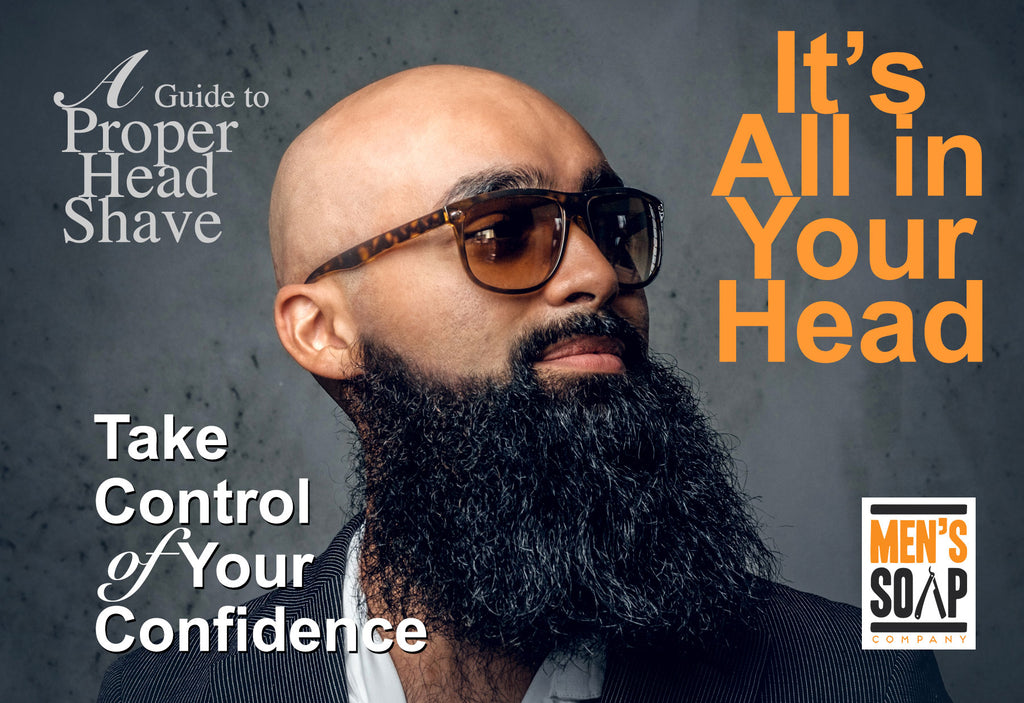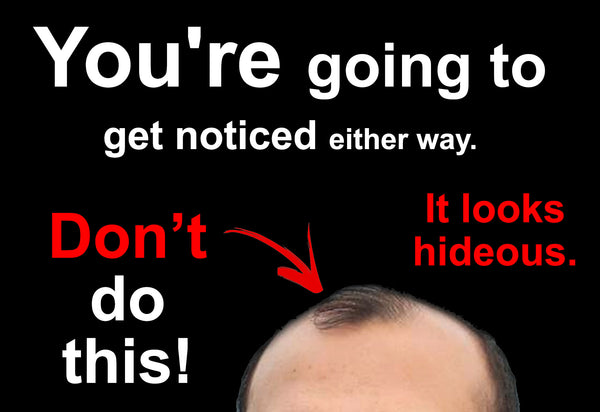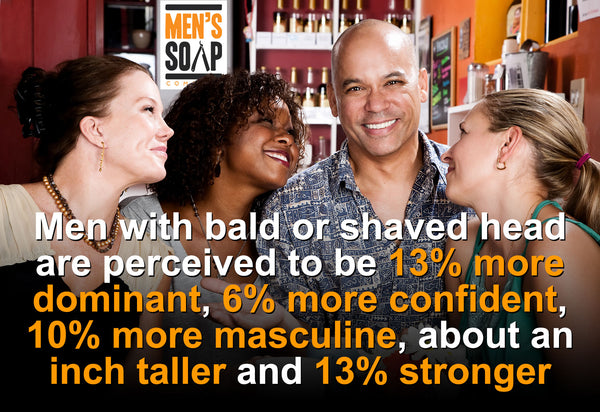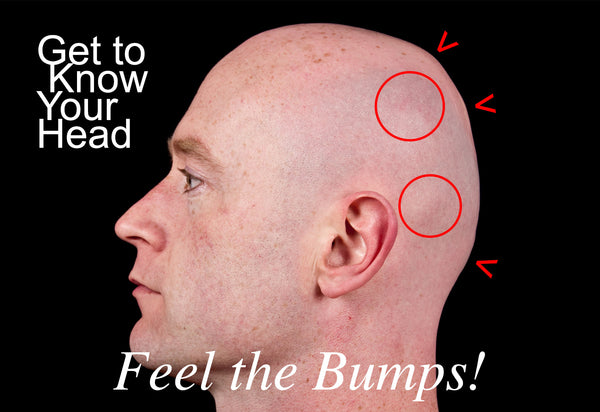Been Thinking About Going With a Fully Shaved Head, But Still on the Fence? Realize the Benefits of Shaving Your Head!

Skip to: Head Shaving How-To Guide with Products, Tips & Tricks
Embrace It Early
The hard truth about male pattern baldness is that there is no cure for it. If you're balding in early age, start preparing yourself for a shaved head soon because 40% of men have noticeable hair loss by age 35, 65% by age 60, 70% by age 80, and 80% by age 85 [1]. The sooner you come to terms with it, the easier the idea of a shaved head will sink in.

Men who do not embrace going bald in early stage typically become in denial and continue rest of their lives with patches, landing strip and combover that make them subject of undesirable conversations, especially among women. This unpleasant attention contributes to developing anxiety, depression and dwindling self-esteem. Shave your head fully and you'll be noticed differently: A bold new you!
It's Empowering
Fully shaving your head takes a great amount of courage. Fret not, gentlemen, with courage comes great rewards. Ladies love men with the confidence to rock a shaved head.

In fact, Psychology Today reported that men with fully bald or shaved head are perceived to be 13% more dominant, 6% more confident, 10% more masculine, about an inch taller and 13% stronger [2]. With these numbers, it's not a surprise that even non-balding men are shaving their heads nowadays. Hey, if it works, why not?
Beard & Bald Head Combination Changes Everything
If you don't like the way your shaved face looks with your shaved head, consider keeping your beard because it will restore the balance to your face shape. The perfect way to hide those double chins or whatever else you don't like being exposed. Also, there are beard shaping techniques that will give you the jawline you always wanted.

You can decide to keep a little bit of beard to full blown hipster. Ask the ladies in your life to help decide on this, as they will know how to judge your look better than your already self-conscious-self.
Ready To Shave Your Head? Understand the Fundamentals of Head Shaving.
Watch this video: Tips & Tricks for Shaving a Bald Head | No Cuts or Bumps
1. Get to Know the Shape and Scalp of Your Head

- Buzz your head with a trimmer at the lowest clip setting possible.
- Then, run your fingers all around your head and make a mind map of the shape.
- Pay close attention to all the bumps, you'll need to be more gentle over these areas to avoid cuts.
- Try to get a feeling of your hair growth direction, the grain of the hair. We'll revisit this in The Shave section below.
2. Pre-Shave Preparation
- Hydration is an absolute must.
- Shaving after a shower is ideal, your skin will be well hydrated.
- You may opt to use a pre-shave oil instead.
- Some employ both methods to ensure the best results.
3. Shaving Brush & Lather
- Buy synthetic hair brushes because they are cruelty-free, are not affected by hard water issues, and perform well in any condition. Horse hair brushes are good as well, they are also cruelty-free because horse mane and tail is part of their regular grooming, but can perform less in hard water. Boar and badger hair brushes are not recommended, as they are made by killing and harvesting the hair from the animals.
- Get a really good shaving soap or cream that creates a thick lather, provides plenty of cushion and slickness, allowing the razor to glide over the skin effortlessly.
- If you decide to buy our shaving soap refill pucks, you can skip using a brush and directly apply the soap to your scalp like a normal body soap. Then, build lather using your hand, which is one of the many great benefits of using a hard shaving soap.
- Make sure it's made from natural ingredients and alcohol-free.
- Why? Because skin from your head differs from the skin over your face.
- Scalp absorbs moisture and dries quicker, and synthetic ingredients, especially alcohol, will cause a drought like surface that'll guarantee cuts, razor burns, and bumps.
- Cuts on scalp bleed more and irritation bumps are visibly bigger.
- Seriously, take your time lathering. Your skin will thank you for it.
Check out the video on How to Lather Shaving Soap in a Bowl or Mug
4. Razor & Blade
- The best options:
- Double Edge safety
- If your hair is thin and soft, go for an open-comb razor, as the solid bar or closed-comb will flatten the hair down first, causing the blade to miss some, and ultimately requiring multiple passes.
- Single Edge safety
- And, if you dare, Straight razor
- Recommended blades (Beginners, Intermediate, Experienced, All Levels):
- Astra Platinum (Russia)
- Derby Extra (Turkey)
- Feather (Japan)
- Gillette 7 O’Clock (Russia)
- KAI Stainless Steel (Japan)
- PolSilver Super Iridium (Poland)
- Shark Super Stainless (Egypt)
- Wilkinson Sword Classic (Germany)
- What about cartridge razors?
- Cartridge razors do the job just fine, but they do have downsides.
- Cartridges are very costly compared to Double Edge or Single Edge blades.
- They require frequent clearing of clogged blades during shaves.
- Are designed to do like so:
- First blades trims.
- The second blade further cuts down the hair.
- The third blade finishes the job, and so on.
- With each blade pass, your skin is pulled and tugged, which is bad for sensitive skin.
- If you'd rather use cartridge, invest into a cartridge razor that's specifically designed for head shaving.
5. The Shave
- Once the lather is on, you won't be able to see the grain of the hair and bumps at all. This is why step 1 is so important to follow.
- Where do you start shaving? Stretching skin will give you a closer shave, so start from the sideburn where you'll be able to pull it down to stretch.
- For beginners, starting from the sideburn will also help ease your way to the top where holding a razor will feel a bit awkward.
- Take your time! Make every pass consciously. With practice, it will become second nature over time.
- Stick with shaving with the grain, with the direction of hair growth.
- Going against the grain or the opposite direction of hair growth will give you a closer shave, but this method can cause irritation and skin damage, depending on your skin type, especially if you're new to head shaving.
- After you get the hang of shaving your head, and your skin has had time to adjust to your shaving routine, going against the grain will be painless, should you choose to do so.
6. Post-Shave
- Apply aftershave balm or lotion (alcohol-free). Why? Because of dandruff!
- If you use our shaving soaps, this step may not be necessary as our ingredients include Coconut Oil (SPF 4-6 protection), Hybrid Safflower Seed Oil and Sea Butter (SPF 4-6 protection) that are great natural moisturizers.
- Your skin is a living organ and it sheds.
- During shaves, you are essentially scraping away dead skin cells making way for new ones.
7. Maintenance
- Shave your head before the hair gets too long. You don't want to wait until re-trimming is needed.
- After all, the point of shaving your head if you're balding is to prevent the patches and landing strip appearance from resurfacing.
- Moisturize and protect your scalp as often as you need between shaves.
[1] https://www.statisticbrain.com/hair-loss-statistics/
[2] https://www.psychologytoday.com/us/blog/the-mating-game/201612/do-women-find-bald-men-be-more-attractive
